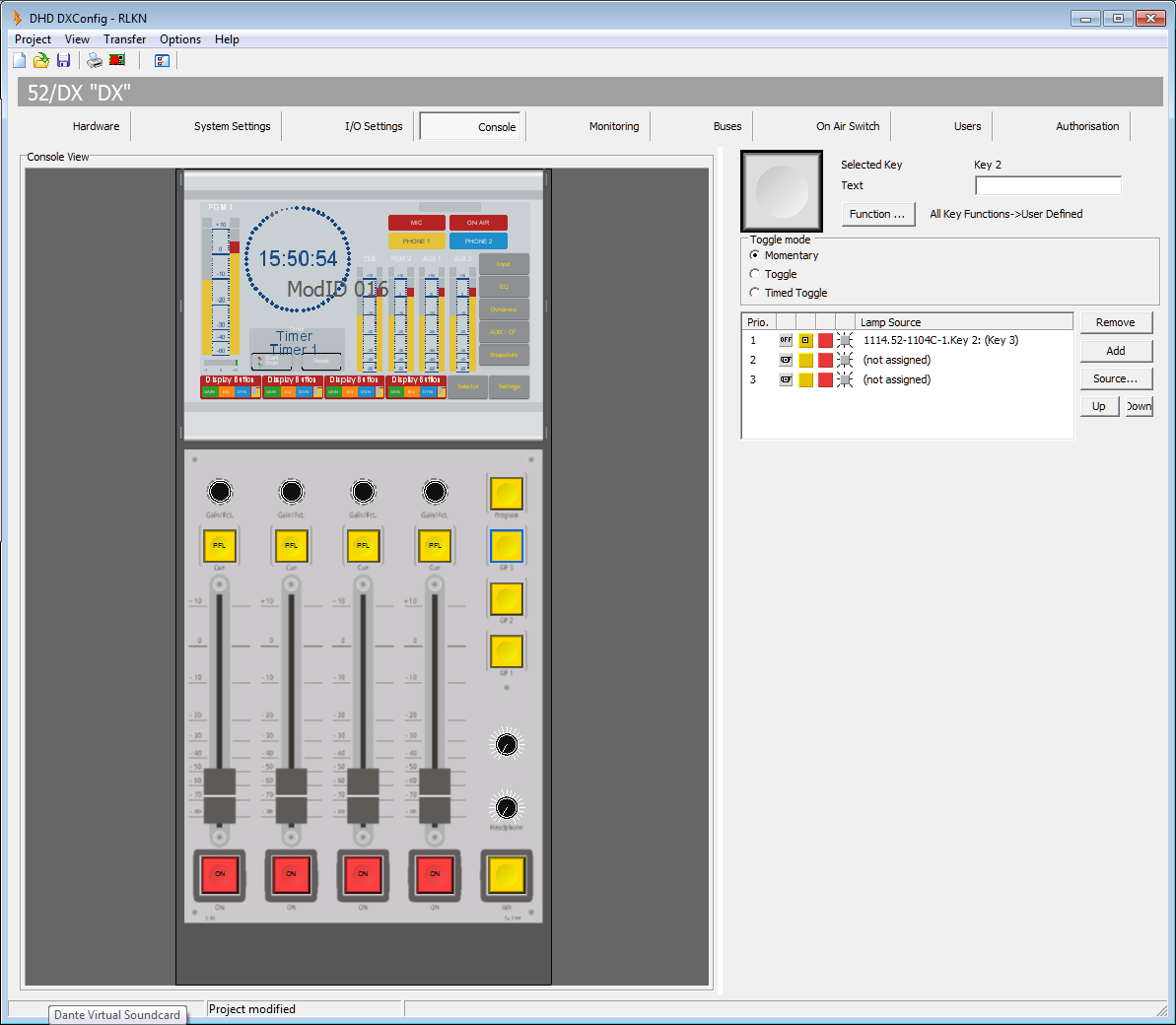Console
On the Console page you can configure keys and TFT views.

To configure an element, select it by clicking in the Console View area. Its options are shown in the area to the right of the Console View area.
TFT/Touch Display Element
| option | description |
|---|---|
| Default View | In this list, all available default TFT views are shown. Select a default view from the list. (For differences between the default views see Default views table below) |
| Show System Messages | Select the check box in front of the system message to enable it on the TFT/Touch Display. |
Key Element
| option | description |
|---|---|
| Number | Shows the generated number of the selected key: <name of fader module>.Key<key number on this module> |
| Function | Shows the assigned key function. To change the default key function of a key, follow these steps: 1. Select a key on the console view. 2. In the View menu, select Key Functions. The Key Functions window opens.3. In the Key Functions window select a Key Function from the list and click Select. |
| Label | Enter a name for the key. This name will be shown in the Console View and will be available for the label print feature. |
| Colors | Depending on the selected key function, you can define here, with which color the key shall light up according to the lamp source. On is the color if the function is enabled, Off if the function is in inactive condition. For the last case, mostly the Off option is used, for example the key does not light up. Depending on the selected key function, you find also different names in the Lamp Source column, for example Standby, Available, Busy, Owned, Layer A, Layer B or the name of the selected lamp source. You can define the colors red and yellow. You can define flashing colors for the keys. Select the check box, in the Colors area. To change the logic source for a color, select an entry in the Lamp Source column and click Source. The Logic Sources window opens. In the Logic Sources window, select a logic source from the list and click Assign. |
| Toggle Mode | Momentary - The function is enabled as long as the key is pressed.\\ Toggle - This key is stay put.\\ Timed Toggle - This key is stay put (short press) or spring return (long press). |
Monitoring key - Program
Press the Program key, to send the PGM 1 bus audio signal to the Mon1 bus. When the Program key is not active, the audio sources which is selected in the Selector view on the TFT is sent to the Mon1 bus. To set the audio source for this Mon1 bus, follow these steps:
- On the TFT Touch display tap on the
Selectorbutton. TheSelectorview is shown. - At the bottom of the TFT Touch display, tap on
Selector. - In the
Selector Sourcesarea, tap on the audio source that should be routed to theMon1bus.
General Purpose keys - GP1, GP2, GP3
You can configure these keys as User Defined Key.
User defined:
- By right-clicking
(not assigned)in theLamp Sourcecolumn, you can either select the key itself as a source or select any source from thelogic sourceswindow. - You can use the key as a logic source in many ways, for example for the On-Air Switch or routing to GPOs.
- You can change the sequence of the three rows in the Colors area. Drag a row in the
Lamp Sourcecolumn to its new priority place. - The LED with higher priority lights up if its lamp source is active; two colors can't light up at the same time!
- The LEDs of the keys can also be used to show a condition without having assigned a key function. This is useful for signalisation via GPIs.
Key - Talk
You can configure this key only as User Defined Key.
User defined:
- By right-clicking
(not assigned)in theLamp Sourcecolumn, you can either select the key itself as a source or select any source from thelogic sourceswindow. - You can use the key as a logic source in many ways, for example for the On-Air Switch or Talkback.
- You can change the sequence of the three rows in the
Colorsarea. Drag a row in theLamp Sourcecolumn to its new priority place. - The LED with higher priority lights up if its lamp source is active; two colors can't light up at the same time!
- The LEDs of the keys can also be used to show a condition without having assigned a key function. This is useful for signalisation via GPIs.
Default views
In the following table, the differences between the default TFT views are shown.
| view name | standard elements (Std) (PGM peak meter, CUE peak meter, 4 state indicators, navigation buttons, user name) | clock (Clk) | three additional peak meter for PGM 2, Aux 1, Aux 2 (3PM) | timer (Tmr) | sync status indicators |
|---|---|---|---|---|---|
| Std+Clk | X | X | X | ||
| Std+Clk+3PM | X | X | X | X | |
| Std+Clk+3PM+Tmr | X | X | X | X | |
| Std-CUE+Clk | X (without CUE peak meter) | X | X | ||
| Std+Tmr | X | X | |||
| Std+3PM+Tmr | X | X | X | ||
| Std | X | ||||
| Std+Clk+Tmr | X | X | X |
X: the element is available in this view